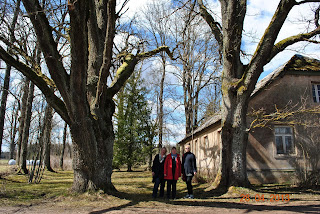Like many Canadians, I have more than
one ancestral home. I've been fortunate to visit several.
Confession: Depending on the advance research I did, and/or
the resources available when I got there, it seems I rarely got
answers to the unknowns. In fact, I know now I did not always ask the
right questions at the moment I was there or even make the best use
of my time in terms of information-gathering.
 |
| Left: The revered oak tree of family memory |
So be it. There is much to be said for
soaking up environ-ment―all
sensual sights, sounds, smells, tastes, touch, sentimental
triggers―and the
special effects of new people.
It was a happy day to meet for the
first time many maternal relatives; my family members shared the
enthusiastic greetings and enjoyed their hospitality. Who does not
have a mother / aunt / cousin who says "You must eat everything on
the table"?! So Rasma and granddaughter Zane and others welcomed
us at the farm where generations of Freibergs and Lindes have
persevered agriculturally, through oppression, resistance fighting,
military battles, deportation, and struggles—that
we in North America can hardly begin to imagine. And
that was just the twentieth-century! Two revolutions and two
World Wars in your backyard. Epic hardship that made small periods of
peace and happiness that much sweeter.
The table was laden with special
treats. We had an orgy of photo-graph reviewing (and eating) with
memories and mutual story exchanges facilitated by Madara and Zane.
We are humbled that they are fluent in English while we have only
mastered a few Latvian words. Last year's mid-summer dried wreathes
of oak leaves hang above us, bestowing good vibrations from the
traditionally-revered tree.
Our mutual ancestor Ansis Freibergs came to Kalna Ķonēni by about 1840 with dairy farming experience. His gift for gardening is vivid in the family memory. In spite of all the intervening disruption and terror, his great-great-grandson Normands operates a dairy farm today. The extended family gathers several times a year to help with seasonal chores.
Our mutual ancestor Ansis Freibergs came to Kalna Ķonēni by about 1840 with dairy farming experience. His gift for gardening is vivid in the family memory. In spite of all the intervening disruption and terror, his great-great-grandson Normands operates a dairy farm today. The extended family gathers several times a year to help with seasonal chores.
 |
| Mālpils Lutheran Church |
 |
Mālpils
Cemetery
|
Our hosts took us on a marvellous
countryside tour relevant to all the places I mentioned in My
Latvian Ancestors (gleaned from all those parish registers and
other Raduraksti sources1), truly a hands-on visit.
The ruins of the Vatrāne
estate community; the Taurupe Manor owned by the same landlord;
Keipene, Madliena, Suntaži,
and finally Mālpils,
location of the Lutheran church where historical family sacraments
took place, and the cemetery. Some of the "seasonal chores"
for the entire family include caring for the family burial plots
where Ansis lies with his wife Truhte, son Otto and wife Ilze, and
more.
Zane shows us the ruins of Madliena
school-house, now being restored; most probable execution site of
reform leader Otto Freibergs in 1906.
The young people in this family are
aware of their history through long family ties to the same
community. But they are forward-looking, cosmopolitan, optimistic ...
endearing.
When I read of the hard-won Latvia
independence being shattered in the 1940s; when I hear the stories of
Kalna Ķonēni
farmhouse being spared from the torch in order to treat wounded
soldiers; when I see the fruition of labours begun almost two
centuries ago; absorbing the sentient heritage around me
continues to thrill, that this tiny nationality survives with such
spirit.
These are very strong people I come
from.
1. Latvia State Historical
Archives, Raduraksti
(http://www.lvva-raduraksti.lv/en.html)
online historical resources.
[Second of four "Hands On Latvia"]
Photographs: BDM, CDM, CBM, April 2013 (thank you!)
Photographs: BDM, CDM, CBM, April 2013 (thank you!)
©
2013 Brenda Dougall Merriman

















